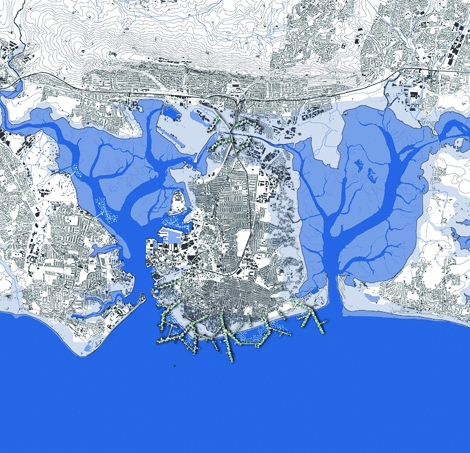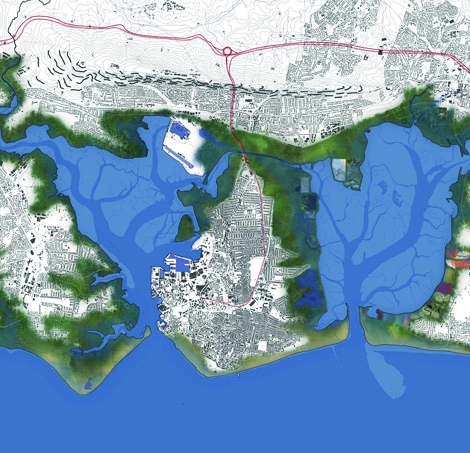
Amsterdam, Bruges and Saint Petersburg have all at one time been crowned the ’Venice of the North’. In 90 years time, if the engineers behind a new report have their way, Hull could join this list of celebrated cultural landmarks.
While such a drastic transformation of a Yorkshire port is likely to raise some eyebrows, the report, Facing up to Rising Sea Levels: Retreat, Defend, Attack? from the Institution of Civil Engineers (ICE), argues that radical changes are needed to protect the UK’s coastline against the increasing threat of rising sea levels, sinking landmasses and more frequent rainstorms.
According to the Environment Agency, more than five million people in England live or work in 2.4 million properties that are at risk from flooding. Around 490,000 of these are under significant threat and this could rise to 840,000 by 2035 if future investment is kept at current levels.
Events such as the summer 2007 floods and the more recent devastation in Cumbria are increasingly bringing the reality of these figures home. The government is also waking up to the issue and has commissioned a report into a national long-term investment strategy that sets the case for doubling investment in flood defences to £1bn a year.
However, Ben Hamer, chair of the Facing Up to Rising

Sea Levels steering group, points out that this is the minimum increase in funding required to maintain current protection levels. ’Clearly the existing strategy does not go far enough,’ he said. ’Government plans will not save any more properties than those currently protected… We need to have a dramatic rethink of how we address this very real threat.’
Hamer, along with ICE and the Royal Institute of British Architects’ (RIBA) think tank, Building Futures, has outlined a range of defence, attack and retreat options to tackle the risk of flooding in coastal cities. The research presents six scenarios set in the year 2100 focusing on the cities of Hull and Portsmouth — two of the UK’s highest flood-risk areas.
The proposed solutions are radical, but grounded in realistic briefings. In Hull, a retreat strategy sets the scene for moving the majority of the city’s population from east to west, with the old city forming an island linked to the retreated community by several bridges.
Portsmouth would also retreat to higher ground within the centre of Portsea Island. The existing M27 would move behind the hills to the north of the city and the Hayling Island coast would become host to a variety of industries that work within the water, such as algae farming and renewable energy production.
An alternative defend strategy for Hull incorporates commercial development with a series of reservoirs built behind a new outer wall. The reservoirs would be designed to provide development on top of the walls, which could help offset the cost of the construction of the new defences.

Similar plans for Portsmouth would see new tide gates to the harbour with a ’living wall’ built for the outer coastline inhabited with commercial, residential and recreational actives.
These forward-thinking options take inspiration from many of the hard engineering solutions currently used along Britain’s coastal cities. However, the authors of the report have gone further with a bold attack strategy that embraces water as part of future infrastructure plans. David West, one of the architects behind the design, believes that the UK needs a radical change in attitude to make up for some of the inherent flaws in the use of existing flood defences.
’We really wanted to get people thinking,’ he said. ’What if in 2100 we chose to create something that is actually quite similar to the attraction of Venice? Perhaps with a raised promenade, a belvedere, create a real sense of arrival, a real sense of edge. What happens if we then kind of let it go and let the water in on either side? Are we fighting something that we are inevitably in the end going to lose?’
The questions raised by West take shape in a re-engineering strategy for Hull involving the use of decommissioned North Sea oil rigs. These would provide a network of static platforms and floating structures in the Humber estuary. Some of the rigs would be used for housing while others could become parks or entertainment complexes. Each would be linked by walkways, Venetian-style boat taxis and bridges.
The industry has got enough imaginative talent to blend hard engineering, with soft engineering and environmental protection… We can look to projects throughout the world, such as the Louvre in Abu Dhabi, as great examples. We have the technology to do all of this, we now need to be creative in using it.
David WIlkes, Arup
Plans have also been drawn up for energy to be generated by small-scale wind turbines on top of the rigs and tidal-flow turbines suspended beneath. Hamer said that this has the potential to provide localised energy and could be extended to any property built on stilts above the water: ’Our view is that these sustainable communities will be looking in the long run towards more domestic-scale sustainable power generation rather than the large schemes that are the focus of the industry at the moment. This has huge potential and may be easier to roll out in the long term.’
In a similarly striking scenario, two-tiered large piers would emerge from Portsmouth city with the lower level used for traffic and the upper area dedicated to residential and commercial space. These piers take the place of groynes to interrupt the water flow and prevent excess erosion on the coastline. Existing buildings in vulnerable areas on the island would be retro fitted to adapt to the flood risk, and new developments, such as stilted and floating communities, would be built with higher water levels in mind.
Water damage
Facts and figures relating to the UK’s vulnerability to flooding
- The length of the UK coastline is about 12,429km, compared to the coastline of Italy (7,600km), Spain (4,964km), France (3,427km) or the Netherlands (451km)
- In England, the cost of claims from flooding in June and July 2007 exceeded £3.5bn
- Home insurance firms are expected to lose £4bn a year by 2035 on repairing flood water damage
- After 100mm of rain fell in 24 hours in Hull during the summer of 2007, 600 streets, nearly 9,000 homes and 91 of the city’s 99 schools were flooded
- Annual flood defence spending must increase to at least £750m to maintain design-specification levels of protection
- Currently, most new flood defence schemes reduce expected damage by at least £8 for every £1 spent
West conceded that such a strategy would expose other areas of the city to rising sea waters with space taken up by the rigs and floating platforms that could otherwise be used for hard flood defences. But the economic benefits, he claims, would outweigh the cost and sustainability of maintaining concrete barriers. ’No one of these six strategies, utopian as they are, is the answer,’ said West. ’It has to be a balance of all three. I think it’s more a case of trying to get people to take this seriously as a general idea.’
Taking these ideas seriously will require engineers to overcome some significant challenges in the near future. ’One of the main challenges to engineers in the UK is the uncertainty in climate change,’ said Hamer. ’There’s still some real substantial ranges in the prediction. You could see somewhere between a metre and half a metre sea level rise. If you take the most extreme predictions, including ice sheets melting, you can get up to 1.9m in the next 100 years. So we need to begin designing structures that are sufficiently flexible to accommodate these sorts of very broad ranging forecasts.’
The technology to design these structures is available and being demonstrated in projects throughout the world. The largest challenge, Hamer believes, is in changing attitudes and driving the political will to take action for the longer term. David Wilkes, an associate director of Arup who has been advising on the designs, said: ’The industry has got enough imaginative talent to blend hard engineering, with soft engineering and environmental protection… We can look to projects throughout the world, such as the Louvre in Abu Dhabi, as great examples. We have the technology to do all of this, we now need to be creative in using it.’




Glasgow trial explores AR cues for autonomous road safety
They've ploughed into a few vulnerable road users in the past. Making that less likely will make it spectacularly easy to stop the traffic for...